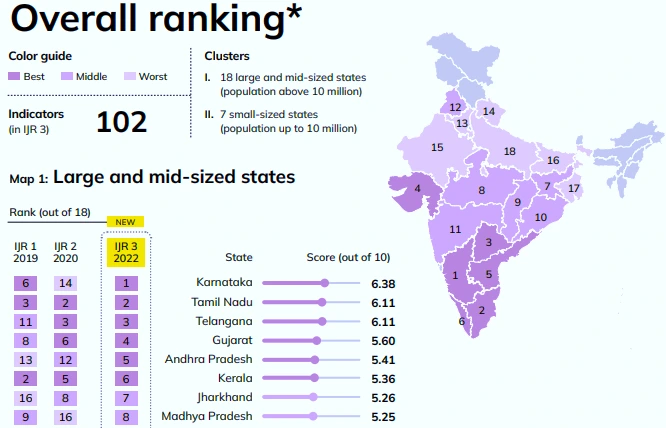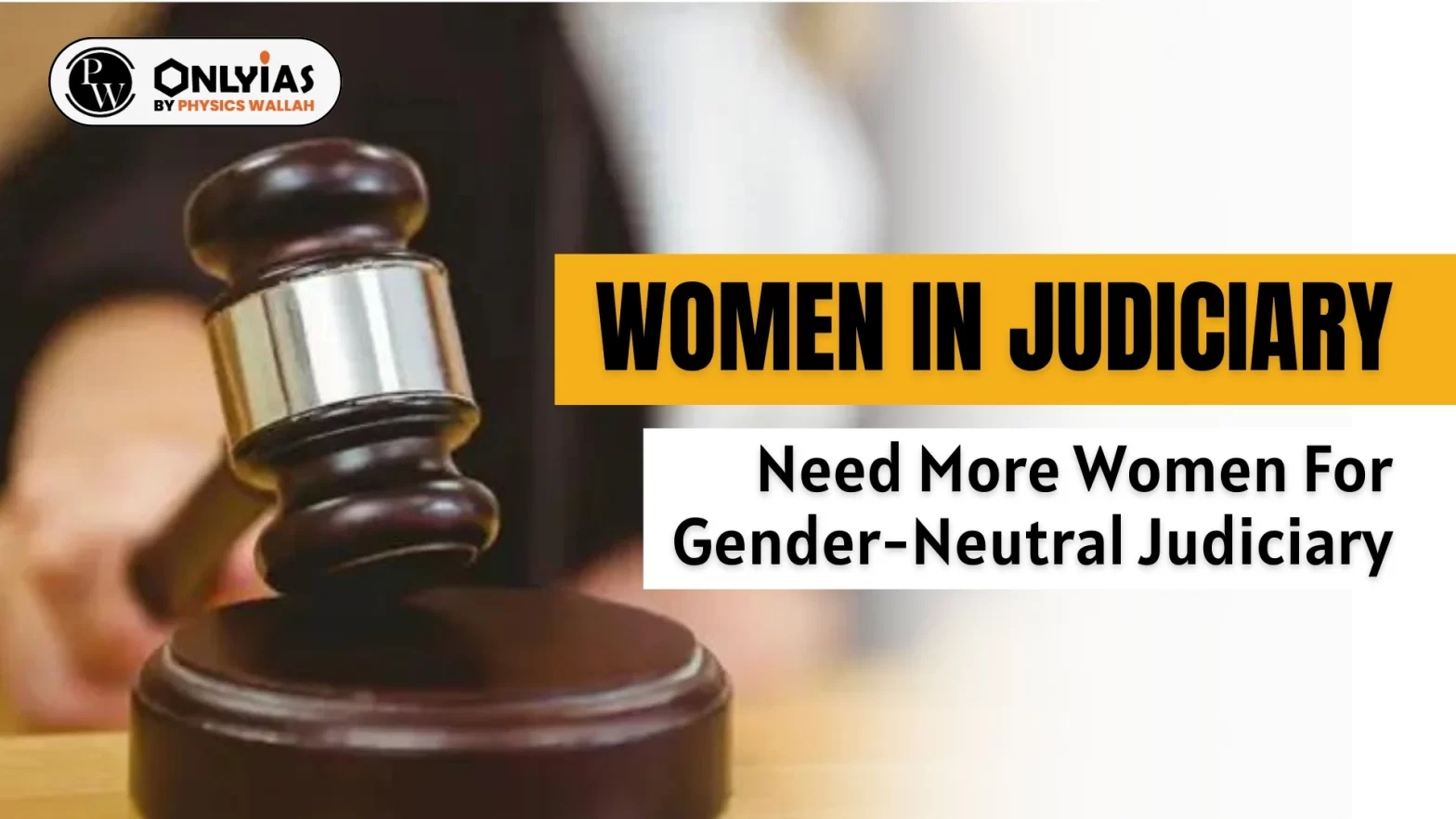Context:
This article is based on the news “SC judge: Need more women for gender-neutral judiciary” which was published in the Times of India. Recently, the Supreme Court judge Justice B V Nagarathna, who will be the 54th Chief Justice of India and the first woman CJI in 2027, advocated for the appointment of more women judges.
| Relevancy for Prelims: Supreme Court of India, Chief Justice of India, State Of The Judiciary Report, India Justice Report (IJR) 2022, and Gender-Neutrality in Indian Justice System.
Relevancy for Mains: Women in Judiciary: Statistics, Significance, Reasons for Low Representation of Women in Indian Judiciary and Way Forward. |
Appointment of Judges in Higher Judiciary
- Constitutional Provisions: Appointments to the higher judiciary are made under Articles 124, 217, and 224 of the Constitution.
- Availability of Reservation: The higher judiciary doesn’t provide reservation “for any caste or class of persons.”
- The first woman Supreme Court Justice in India and Asia was Justice Fathima Beevi. She was appointed to the Supreme Court in 1989.
Also Refer: A Balancing Act Between Centre And Collegium |
Women in Judiciary: Statistics
- India Justice Report (IJR) 2022: As per India Justice Report (IJR) 2022, only 13% of High Court judges and 35% of Subordinate Court judges are women.
- Representation of Women Judges at District Level: Goa (70%), Meghalaya (62.7%), Telangana (52.8%), and Sikkim (52.4%).Representation of Women in India’s Supreme Court:
- Negligible Representation: Among the total 268 judges in the Supreme Court’s history, only 11 have been women. It means, only 4.1% of all Supreme Court judges have been women.
- Current Scenario: There are only three female judges.

-
Representation of Women in Judiciary (High Courts):
- Representation: Presently, India has 25 high courts with a total sanctioned strength of 1,114 judges. Among these, only 107 judges, or 13% of all HC judges, are female.
-
Representation of Women in Judiciary (Lower Courts):
-
- Better Representation: In comparison to the higher judiciary, the lower judiciary has better representation of women judges.
- Reasons: Perhaps the entry to the lower judiciary is through an examination, while the higher judiciary is based on the collegium which informally chooses candidates.
- Availability of Reservation: Several states have provided quotas for women, including Andhra Pradesh, Assam, Bihar, Chhattisgarh, Jharkhand, Karnataka, Odisha, Rajasthan, Tamil Nadu, Telangana, and Uttarakhand.
- They provide 30% to 35% of the total seats for which recruitment is done through direct appointment.
- According to a 2018 study by the Vidhi Centre for Legal Policy, women in judiciary (lower courts) is relatively higher at 27%, it hit a glass ceiling in higher appointments — as district judges and subsequently at the high court level.
Also Refer: Pendency Of Cases In Indian Judiciary
Reasons for Low Representation of Women in Judiciary
- Patriarchal Attitude: The “old boys’ club mentality” makes it harder for women to lobby for judicial posts.
- Also, inadequate support from family results in women frequently dropping out mid-career and it shows the patriarchally prescribed gender roles.
- Household Responsibilities: Women can get into the formal workforce but are often hindered due to the lack of sharing of household chores and the responsibility of bringing up kids.
- Rules and Regulations:
- Continuous Practice: The 7-year criteria of continuous practice for appointment of District Judge under Article 233.
- Age Bar: Most States’ Judicial rule of a minimum age of 35 years for entry as a district judge through direct recruitment.
- Also, no one below the age of 55 years can be appointed as a judge in the Supreme Court.
- Marriage and Family responsibilities in this age group hampers the women’s representation.
- Gender Bias in the Recruitment Process: Appointments to Higher Judiciary is through an opaque Collegium System where the eligibility and selection criteria are not known. As per critics, this system of appointment is based on favorable evaluations and professional/personal networks.
- As per a Research Paper ‘Structural and Discretionary Bias: Appointment of Women Judges in India’ 13 Judges out of 19 interviewed acknowledged the gender bias that exists in the appointment procedure of Judges to the Supreme Court and High Courts.
- Missing a Bond: In 2017, senior advocate Indira Jaising said that though representation of women is increasing but they are isolated and not very bonded.
- Male judges have a friendly body when speaking to male lawyers.
- No Support through Reservation in Higher Judiciary: While reservations for women are available in the lower courts of many states, these policies are yet to be implemented in the Higher Judiciary.
- Neglect of Academicians: There is no provision for the appointment of any distinguished jurist, (where women can make their way) to the supreme court.
- Miscellaneous Factors: Sexual harassment, clients not trusting women advocates with high-stake cases, and lack of supportive infrastructure, from toilets to maternity leave.
- In 6,000 courts across the country, 22% of them do not have separate toilets for women.
Significance of Having More Women in Judiciary
- Improve the Quality of Judicial Review and Adjudication: It is because having more women in judiciary is about:
- The matter of the credibility and legitimacy of courts
- The language and vocabularies of judgments
- The gender-neutral administration of courts
- Having more women on the bench can contribute to a more effective space to deliver justice in India.
- Example: Justice Sujata Manohar was responsible for writing up the revolutionary Vishakha Guidelines.
- A Step towards the Empowerment of Indian Women: The Indian judiciary marshaled women’s fights for equality, equal opportunity, dignity, and autonomy, and having more women on the bench, will lead to women’s empowerment and justice.
- Wider Justice and Inclusivity: It can help to reduce the high pendency of cases in the judiciary, and also, higher numbers of female judges can increase the willingness of more women to seek justice.
- Adequate women’s representation will meet the needs of women and other underserved communities.
- Availability of Varied Views: A high diversity of judges would bring different and better perspectives and enrich and strengthen the ability of judicial reasoning to encompass and respond to varied social contexts and experiences.
- Increase Gender Sensitivity in the Judgements: There are various instances when women’s protection laws are diluted without considering the issue’s sensitivity. But with more women representation in the judiciary, this problem will also be resolved.
- Action on International Obligations: Sustainable Development Goal 5 of the United Nations calls for attaining gender equality and the greater representation of women in judiciary would be a desirable step in the achievement of the obligations.
Way Forward to the Gender-Neutral Judiciary
- Sensitization through Inclusivity: There is a need to bring institutional, social, and behavioral change by sensitizing and emphasizing inclusivity. All India Bar Examination should contain questions or sections relating to gender sensitization.
- Former CJI Justice Chandrachud correctly observed that the Feminist approach should be imbibed while dealing with the law.
- Overcoming Patriarchal Mindset: The representation of women in judiciary needs to be increased, and for this, the change of patriarchal mindset is most important. Unless women are empowered, justice cannot be done for them.
- It should be the realization that women are not subordinate in marriage and should be encouraged to balance work and family life.
- Reservation for Women in Higher Judiciary: For Women, in the appointment of higher judiciary the provision of the reservation should be incorporated without diluting the merit.
- Former CJI Justice Ramanna had exhorted women lawyers to strongly raise their demand for 50% reservation in the judiciary.
- Formation of Gender Bias Task Forces: Similar to the Gender Bias Task Forces in the US, which look at how gender affects court systems, India needs to form such a committee to provide significant suggestions (International Association of Women Judges, 2019).
- A Mentorship System to Counter Challenges: The Geneva Forum on Women in Judiciary (2013) suggested a mentorship system where senior women judges and lawyers can help and guide their younger peers by providing valuable suggestions to counter the challenges they face.
- Modifications in the Rules and Regulations: There is a need to lower the minimum age requirement for the appointment of a district judge.
- The government and Judiciary can provide relaxation to the seniority principle to ensure gender diversification and justice.
- There is a need to enhance transparency in the judicial system.
- Conducive environments and adequate opportunities should be created for women.
- Inclusion of Distinguished Women Jurists: It can help in tackling the criteria of geographical representation in the Supreme Court as many times there are no women judges in a particular geography.
- Need For a Road Map: To counter the gender gap, the apex court is required to create a vision document to bridge the gender gap in the Judiciary.
Conclusion
The lower representation of Women in judiciary (higher) remains a persistent challenge that needs to be addressed comprehensively. The steps need to be taken to promote diversity and equal opportunities, which would consecutively strengthen the Indian Justice System.
![]() 11 Jan 2024
11 Jan 2024


